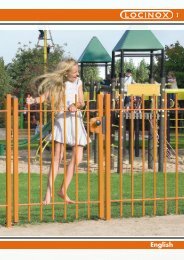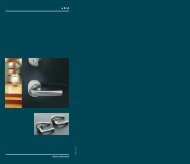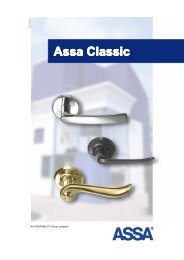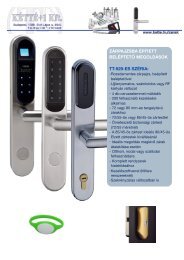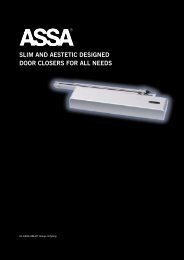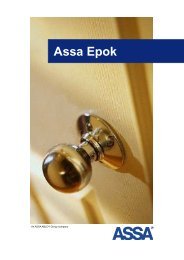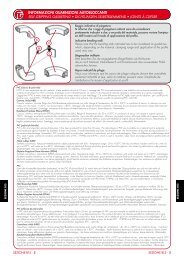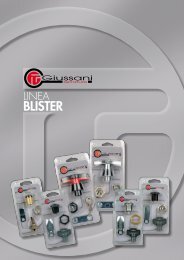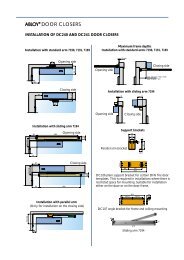Catalogo completo 2012 - pdf 50 MB - Giussani serrature
Catalogo completo 2012 - pdf 50 MB - Giussani serrature
Catalogo completo 2012 - pdf 50 MB - Giussani serrature
Sie wollen auch ein ePaper? Erhöhen Sie die Reichweite Ihrer Titel.
YUMPU macht aus Druck-PDFs automatisch weboptimierte ePaper, die Google liebt.
INFORMAZIONI GUARNIZIONI AUTOBLOCCANTI<br />
SELF-GRIPPING GASKETING • DICHTUNGEN SELBSTKLEMMEND • JOINTS À CLIPSER<br />
INDICE<br />
Raggio indicativo di piegatura.<br />
Si informa che i raggi di piegatura indicati sono da considerarsi<br />
prettamente indicativi e che possono variare a seconda del materiale,<br />
dell’ampiezza dell’incastro e del modo di applicazione del profilo utilizzato.<br />
Indicative bending radii.<br />
Please note that the bending radii indicated are to be considered as guidelines<br />
which, depending on the material, clamping range and application of the profile<br />
used, may vary.<br />
Biegeradien indikativ.<br />
Bitte beachten Sie die angegebenen Biege-Radien als Richtwerte,<br />
die je nach Material, Klemmbereich und Einsatzzweck des verwendeten Profils<br />
abweichen können.<br />
Rayon indicatif de pliage.<br />
Nous vous informons que les rayons de pliage indiqués doivent être considérés<br />
seulement indicatifs et que puissent varier selon le matériel, l'amplitude de<br />
l'emboîture et le moyen d'application du profil utilisé.<br />
SEZIONE B15<br />
PVC (cloruro di polivinile)<br />
Il PVC è il più importante tra tutti i polimeri. Viene prodotto da più di 55 anni. I vantaggi del PVC sono ad esempio la sua stabilità e la sua buona resistenza alle condizioni<br />
atmosferiche. Non si corrode, è ignifugo e non si de-polimerizza. Di contro, la formazione di diossine durante la combustione è un grosso svantaggio. Oggigiorno<br />
il PVC è molto usato per la costruzione nel campo medico e per imballaggi. C’è inoltre differenza tra PVC rigido usato per le tubazioni, per i profili per le finestre e per<br />
i bordi (PVC: 77-89%) e PVC morbido che è usato come isolante, tubi, pavimenti, e profili di protezione(PVC: 44-61%).<br />
Gomma nitrile (NBR)<br />
Caucciu’ sintetico, Gomma Poliacrilico-Nitril-Butadiene polimerizzata con zolfo. Range di Temperatura: da -20 a 100°C in condizioni di secco, si indurisce con aria<br />
calda, con olio sopra i +120°C, con acqua sopra i +80°C. Vantaggi: alta resistenza termica a petrolio, a benzina, buona durezza meccanica, bassa deformazione<br />
residua sotto pressione. Svantaggi: resistenza molto bassa al deterioramento e all’ozono, bassa elasicità, infiammabile.<br />
Butadiene-Propilene-Etilene (EPDM)<br />
Caucciu’ sintetico, termopolimeri (EPDM polimerizzato con zolfo). Range di Temperatura: da -<strong>50</strong> a +120°C in condizioni di secco; con acqua e vapore sopra ai<br />
130°C. Vantaggi: eccel-lente resistenza alle condizioni atmosferiche, così come alla vecchiaia , all’ozono, ai prodotti chimici, all’acqua calda ed al vapore; buona<br />
resistenza ai fluidi polari come l’acetone, il meta-nolo ecc.., proprietà di isolamento elettrico, bassa permeabilità al vapore, Buona resistenza termica, Temperatura di<br />
fragilità estremamente bassa. Svantaggi: bassa resistenza ad idrocar-buri aromatici ed alifatici (oli minerali, petroli, combustibili); Infiammabile.<br />
PVC (polyvinyl-chloride)<br />
PVC is the most important among all polymers. It has been produced for more than 55 years. The advantages of PVC are its stability as a material and its extremely<br />
good resistance against weather for example. It does not corrode, is hardly flammable and does not de-polymerize. Yet, the formation of dioxines during combustion is<br />
an extreme disadvantage. Nowadays, PVC is mostly used in construction, medicine (in instruments, not drugs) and packaging. There is a difference made between hard<br />
PVC, used in pipes, profiles for windows and borders (ratio of PVC: 77-89%) and soft PVC, which is used in insulation, tubes, floors and edge protection profiles (ratio of<br />
PVC: 44-61%).<br />
Nitrile rubber (NBR)<br />
Synthetic caoutchouc, Polyacryl-Nitrile-Butadiene rubber polymerized with sulfur. Temperature range: -20 to +100°C with dry conditions, hardens with hot air, with oils<br />
up to +120°C, with water up to +80°C. Advantages: High oil, petrol and thermal resistance, good mechanical toughness, low remaining deformation under pressure.<br />
Disadvantages: Very low weather and ozone resistance, low elasticity, flammable<br />
Ethylene-Propylene-Diene Monomer (EPDM)<br />
Synthetic caoutchouc, terpolymers (EPDM polymerized with sulfur). Temperature range: -<strong>50</strong> to +120°C dry conditions; with water and steam up to 130°C. Advantages:<br />
Excellent weather resistance, as well as to ageing, ozone, chemicals, hot water and steam; good resistance to polar fluids such as acetone, methanol etc., outstanding<br />
electrical insulation properties, low steam permeability, good thermal resistance, extremely low brittleness temperature. Disadvantages: Low resistance to aliphatic and<br />
aromatic hydrocarbons (mineral oil, petrol, fuels); Flammable.<br />
PVC<br />
Unter den Kunststoffen besonders bedeutend, ist das PVC (Polyvinylchlorid). Es macht etwa ein Viertel der deutschen Chlorproduktion aus und wird seit mehr als 55 Jahren<br />
produziert. Seine Vorteile sind, daß es ein stabiler Werkstoff ist und sich durch eine besondere Widerstandsfähigkeit auszeichnet. Es ist desweiteren witterungsbeständig,<br />
korrodiert nicht, es ist schwer entflammbar und depolymerisiert nicht. Doch ein extremer Nachteil ist die Entstehung von Dioxinen bei der Verbrennung. PVC wird heute<br />
hauptsächlich im Bauwesen, in der Medizin (in Form von Geräten, nicht als Medikament) und im Verpackungswesen verwendet. Dabei unterscheidet man Hart-PVC, das<br />
in Rohren, Fensterprofilen und Leisten verwendet wird (PVC-Anteil 77-89%), und Weich-PVC, das als Isoliermaterial, in Schläuche, Fußböden und Kantenschutzprofilen<br />
Verwendung findet (PVC-Anteil 44-61%).<br />
Nitril-Kautschuk (NBR)<br />
Synthetischer Kautschuk, Polyacryl-Nitril-Butadien-Kautschuk, mit Schwefel vernetzt. Temperatureinsatzbereich: -20 bis +100°C trocken, verhärtet in Heißluft, Öle bis<br />
+120°C, Wasser bis +80°C. Vorzüge: Hohe Öl- und Benzin-Beständigkeit, hohe Hitzebeständigkeit, gute mechanische Festigkeit, geringe bleibende Verformung unter<br />
Druck. Nachteile: Schlechte Ozon- und Witterungsbeständigkeit, kurze Dehnung, brennbar.<br />
Äthylen-Propylen-Kautschuk (EPDM)<br />
Synthetischer Kautschuk, Terpolymere (EPDM mit Schwefel vernetzt). Temperatureinsatzbereich: -<strong>50</strong> bis +120°C trocken, Wasser und Dampf bis 130°C. Vorzüge:<br />
Ausgezeichnete Beständigkeit gegen Bewitterung, Alterung, Ozon, Chemikalien, Heißwasser und Wasserdampf, gute Beständigkeit gegen polare Flüssigkeiten<br />
wie Azeton, Methanol etc., vorzügliche elektrische Isolationseigenschaften, geringe Wasserdampfdurchlässigkeit, gute Wärmebeständigkeit, extrem tiefe<br />
Brüchigkeitstemperatur. Nachteile: Geringe Beständigkeit gegenüber aliphatischen und aromatischen Kohlenwasserstoffen (Mineralöle, Benzine, Kraftstoffe), brennbar.<br />
PVC (chlorure de polyvinyle)<br />
Le PVC est le plus important de tous les polymères. Il est produit depuis 55 ans. Les avantages du PVC sont par exemple sa stabilité et sa bonne résistance aux conditions<br />
atmosphériques. Il ne se détériore pas , il est ignifuge et il ne se dépolymérise pas. Par contre la formation de dioxines pendant la combustion est un gros désavantage.<br />
Aujourd’hui le PVC est très utilisé dans le secteur des constructions, dans le secteur de la médecine (pour les instruments) et pour les emballages. Il y a une différence<br />
entre le PVC rigide utilisé pour les conduites , pour les profils des fenêtres et pour les bords (PVC : 77-89%) et le PVC doux qui est utilisé comme isolant, pour la<br />
construction de tubes, de sols et de profils de protection angulaires (PVC : 44-61%).<br />
Caoutchouc nitrile (NBR)<br />
Caoutchouc artificiel, caoutchouc Polyacrylique-Nitril-Butadiène polymérisée avec soufre. Range de température : de –20 à +100°C en conditions de sec , il se durcit<br />
avec air chaude , avec huile au-dessus de + 120°C, avec eau au-dessus de + 80°C. Avantages : haute résistance thermique au pétrole et à l’essence. Bonne dureté<br />
mécanique, basse déformation résidue sous pression. Désavantages : très basse résistance aux conditions atmosphériques et à l’ozone, basse élasticité, inflammable.<br />
Butadiène-propylène-éthylène (EPDM)<br />
Caoutchouc artificiel, thermopolymères (EPDM polymérisé avec soufre). Range de température: de –<strong>50</strong> à +120°C en conditions de sec ; avec eau et vapeur jusqu’à 130°.<br />
Avantages : excellente résistance aux conditions atmosphériques, à la détérioration, à l’ozone, aux produits chimiques, à l’eau chaude et au vapeur ; bonne résistance<br />
aux fluides polaires comme l’acétone, le méthanol etc. Propriété d’isolement électrique, basse perméabilité au vapeur, bonne résistance thermique, température de<br />
fragilité extrêmement basse. Désavantages : basse résistance aux hydrocarbures aromatiques et aliphatiques (huiles minérales, pétroles, combustibles), inflammable.<br />
SEZIONE B15 - 5 SEZIONE B15 - 5



